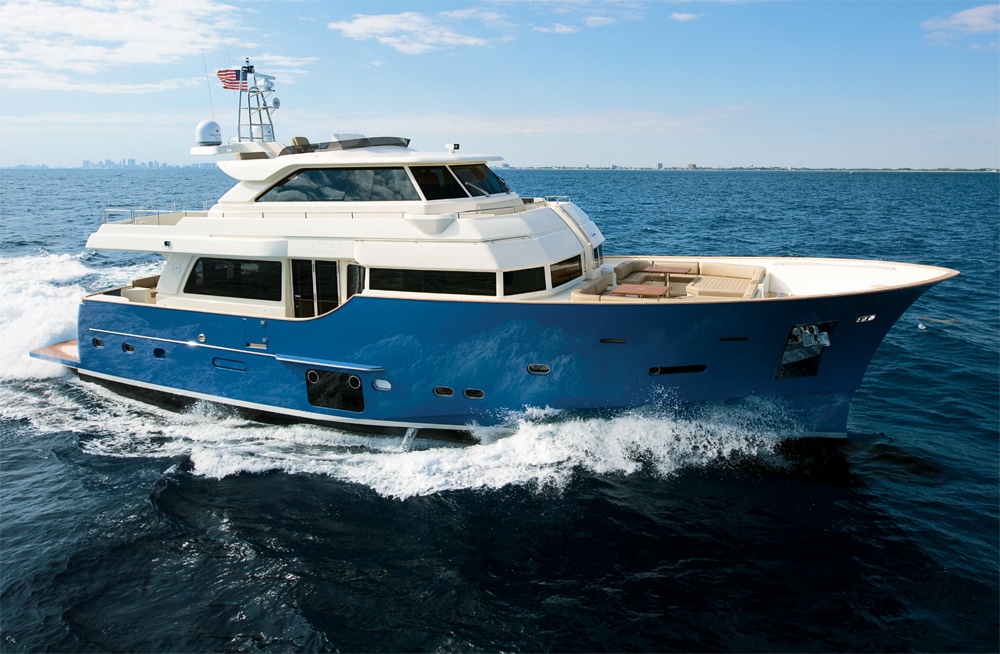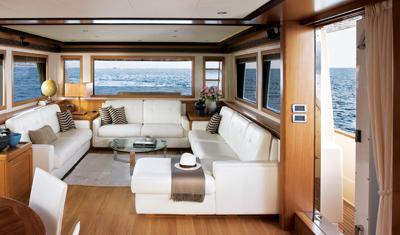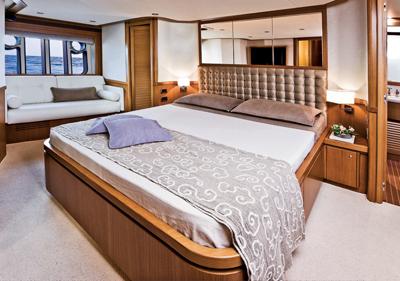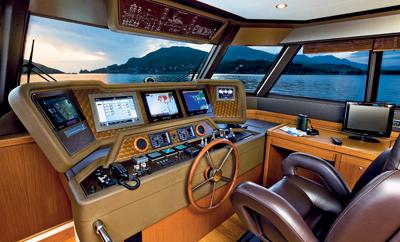
MochiCraft LR23
Here’s what you need to know about the Mochi Craft LR23, whether you buy one or not. It’s quiet. In fact, it’s quiet enough that if you are sitting on your WaveRunner, waiting for your dad to back the trailer into a canal in Ft. Lauderdale, you best look both ways before backing onto that waterway. Because 77 feet of bright blue boat may be making her way past and you won’t want to jump in front. It’s that quiet. Fortunately that kid was careful.
If you happen to be on board when the electric motors engage, you need to be looking at the Naviops control touchscreen to know it, because the usual rumble and vibration that accompany engine startup are not there. And it’s not going to show up, until you get out past the breakwater and engage the twin 900-horsepower MAN diesels for a sea trial. Those engines push the Mochi a bit faster than the electric motors, and operate very quietly in this design.
Seen on the dock, the LR23 is an odd addition to the Mochi Craft lineup, which otherwise consists of boats that resemble an Italian builder’s interpretation of a down east-style cruiser. And to be truthful, the boat seemed a bit slab-sided and stubby when I first looked at her. But step on board and you’ll see that the education yielded plenty of positives. First, like any good Italian, she welcomes guests with comfort and food—step aboard the afterdeck and you’ll find settees and a dining table across the aft bulkhead of the deckhouse.
If you don’t wish to linger here, head forward on one of the side decks. I would have liked a grab rail on the side of the house, since these walkways are the only option to move fore and aft in a seaway. Double doors on either side amidships allow access to a great room saloon-dining area-galley. Three creamy white leather settees ring a round, glass coffee table at the aft end, surrounded by large windows providing light and views. Included in this glass menagerie is an 88-inch-wide picture window looking out to the afterdeck. The window opens electrically, sliding down into the bulkhead and allowing air and conversation to flow between the afterdeck and saloon.

Forward of the entry doors is a clever dining table that adjusts to seat up to eight, and ahead of that is a step up to a galley and dinette area, all surrounded by large windows. On the forward bulkhead, a door leads to an inviting foredeck space, with two more dinettes and sunpads. The airiness and flow of the great room from galley to saloon feels like a summer cottage, with a cool, light oak sole that makes it easy to towel up any drips from the kids running through in their bathing suits. Honey-colored teak is used throughout the joinery in the accommodations spaces and makes for a casual, comfortable feel.
Climb the stairs to the pilothouse, where the technology of the boat’s systems is controlled through touchscreens on the helm from a power-adjusting leather helm chair. An L-shaped dinette with a folding table lets crew enjoy the silent running. A Portuguese bridge offers wing controls and a stairway on centerline down to the foredeck seating area. Our test boat had the optional captain’s stateroom, with en suite head.
Back in the saloon, a flight of stairs leads down to a passageway and the entrance to the master stateroom, a full-beam affair with en suite head with shower and a walk-in locker with plenty of hanging space. Large windows on either side have opening ports for ventilation and let in light onto a desk to port and a white leather settee to starboard.
Leaving the master and moving forward along the passageway, one finds a guest stateroom to starboard with twin-size berths arranged as perpendicular bunks, also with an en suite head with shower. Opposite is a neat pantry and stowage area with a fridge and washer and dryer, convenient for a cold drink or a quick load of wash at all hours. This space becomes the fourth stateroom in an alternate layout.

At the forward end of the passageway is the larger guest stateroom, with a queen-size berth, windows with opening ports, a small desk, en suite head with shower, and a walk-in locker.
In the lazarette with Allied Marine Corporate Captain Rich Jones, I watched as he operated the controls for the hybrid propulsion system, peeking in the open engineroom door as we stood at a large electrical panel with a nine-inch touchscreen installed at eye level. Jones made it look easy, but, as with most touchscreen interfaces these days, the controls seemed pretty intuitive (a nice way to say “idiot-proof ”). A bit of touchscreen 101 helps: Knowing there’s a lag from when the touchscreen button is touched to when it lights up, indicating the command is engaged, will prevent the frustrated and deliberate finger jamming that brings me back to the day my folks got their first TV remote.
That touchscreen—and there is one on the helm as well, with a neat lockout function to prevent meddling from the other screen—offers a window to the heart of the LR23, her hybrid propulsion system. The owner can choose from three modes of operation that offer tradeoffs in speed, range, and emissions. Most familiar is diesel power. The twin 900-horsepower MAN diesels push the boat to a top speed of 15 knots, or a cruise speed of 9.5 knots burning 14.6 gallons per hour for a range of 1,200 nautical miles with a 10-percent reserve. For a faster cruise, 11 knots is the sweet spot, burning 22 gallons per hour. The diesels turn the 70 kW electric motors, mounted between the engines and Vdrive transmissions. The electric motors function as generators when the diesels run, charging the 96-cell Lithium-ion battery banks positioned outboard of the engine on either side.

Diesel-electric is the second mode, and the electric motors are powered by the pair of 35 kW Fischer Panda generators and the batteries to provide speeds of up to 7.5 knots.
The zero-emission mode is the third way to move the Mochi, using just the battery banks to power the electric motors—no diesels, no generators, no fumes or burning fuel. I made it a point to be down in the mechanical space with Jones when he fired up the electric motors. I was feeling a bit warm and hemmed in, warm because it was springtime in Ft. Lauderdale, and claustrophobic because that lazarette, a good-size space—even though it gives up quarters for two crew on the starboard side—holds everything you’d expect to see on any yacht and additional elements of the cooling system for the hybrid drive system, as well as Jones and me.
After the motors both wound up to speed, Jones realized the picture wasn’t quite complete. “Let me just turn off the engineroom blower,” he said, reaching for the breaker. When that fan shut down, it was like a revelation: That’s where the noise—or seemingly 90 percent of it, anyway—was coming from. With the blower shut down, each electric motor hummed softly.
Since the propulsion system combines various technologies, it’s only fitting that the hull would combine diverse elements to result in a shape that’s a bit of a platypus. It incorporates a prominent bow bulb that transitions aft into prop tunnels. As the hull bottom begins to rise up into those tunnels amidships, a pair of sponson-like hull elements descend outboard of the prop tunnels. The large swim platform on the stern is actually an extension of the hull—Jones referred to it as a spoiler. The hull is equipped with four Trac wing stabilizers for underway and twin Mitsubishi ARG stabilizers in the engineroom to reduce motion at anchor.
“This boat, in diesel function, can go more than 12, up to 15 knots without changing any longitudinal trim,” says Andrea Frabetti, head of Ferretti Group’s Advanced Yacht Technology Group. “The transom doesn’t go deeply into the water when you change speed.” Such longitudinal stability should make the yacht more comfortable for guests and the hull shape has the added value of a reduced wake, which fits into the boat’s eco-friendly mission.
Interestingly, Jones told me the boat was designed to explore tidal estuaries where it can rest on the bottom, high and dry on an outgoing tide. Makes sense since those huge battery banks can run house systems without a generator for a full day.
But what about on the water? In the swells and three to fives, the LR23 had some roll, fitting with its high-sided profile, but the motion was predictable. But coming back into the canals of Ft. Lauderdale under the silent power of the electric motors, it’s easy to imagine the joy of entering a pristine anchorage, knowing that your presence is having little effect from fumes or noise. Imagine being able to sneak up on the places where you want to be—whether they’re deserted coves or urban hot spots—and bring your summer house along with you.
LOA: 77’9″
LWL: 70’8″
Beam: 21’7″
Draft: 5’1″
Displ.: 192,251 lb. (full load)
Fuel: 2,061 gal.
Water: 520 gal.
Engines: 2 x 900-hp MAN diesels, 2 x 70 kW ZF electric motors
Price: $5,275,027
Allied Marine Group, (954) 462-5527; www.alliedmarine.com








